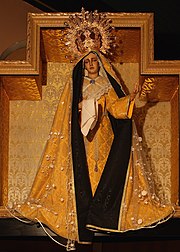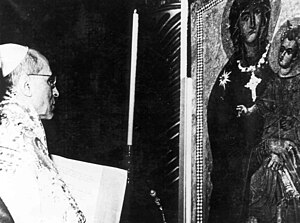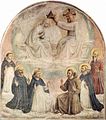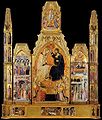Queen of Heaven
Coronation of the Virgin, by Diego Velázquez | |
|---|---|
 | |
| Queen of Heaven, Great Lady, Holy Queen | |
| Venerated in | Catholic Church, Anglican Communion, Eastern Orthodoxy |
| Feast | 22 August |
| Attributes | Blessed Virgin Mary, crown of stars, flowers |
| Patronage | Heaven, eternal salvation to humankind, redemption |
| Part of a series on the |
| Mariology of the Catholic Church |
|---|
 |
|
|
Queen of Heaven is a title given to the Virgin Mary by Christians mainly of the Roman Catholic Church, and also, to some extent, in Eastern Orthodoxy and Anglicanism.[1] The title is a consequence of the First Council of Ephesus in the fifth century, in which the Virgin Mary was proclaimed "theotokos", a title rendered in Latin as Mater Dei, in English "Mother of God".
The Catholic teaching on this subject is expressed in the papal encyclical Ad Caeli Reginam,[2] issued by Pope Pius XII. It states that Mary is called Queen of Heaven because her son, Jesus Christ, is the king of Israel and heavenly king of the universe; indeed, the Davidic tradition of Israel recognized the mother of the king as the Queen Mother of Israel. The Eastern Orthodox Churches do not share the Catholic dogma, but themselves have a rich liturgical history in honor of Mary.
The title Queen of Heaven has long been a Catholic tradition, included in prayers and devotional literature, and seen in Western art in the subject of the Coronation of the Virgin, from the High Middle Ages, long before it was given a formal definition status by the Church.
Theological basis
Queen of Heaven (Latin Regina Caeli) is one of many Queen titles used of the Virgin Mary. The title derived in part from the ancient Catholic teaching that Mary, at the end of her earthly life, was bodily and spiritually assumed into heaven, and that she is there honored as Queen.[3]
Pius XII explained on the theological reasons for her title of Queen in a radio message to Fatima of May 13, 1946, Bendito seja:[4]
He, the Son of God, reflects on His heavenly Mother the glory, the majesty and the dominion of His kingship, for, having been associated to the King of Martyrs in the ... work of human Redemption as Mother and cooperator, she remains forever associated to Him, with a practically unlimited power, in the distribution of the graces which flow from the Redemption. Jesus is King throughout all eternity by nature and by right of conquest: through Him, with Him, and subordinate to Him, Mary is Queen by grace, by divine relationship, by right of conquest, and by singular choice [of the Father].[5]
In his 1954 encyclical Ad caeli reginam ("To the Queen of Heaven"), Pius XII points out that Mary deserves the title because she is Mother of God, because she is closely associated as the New Eve with Jesus’ redemptive work, because of her preeminent perfection and because of her intercessory power.[6] Ad caeli reginam states that the main principle on which the royal dignity of Mary rests is her Divine Motherhood. ... So with complete justice St. John Damascene could write: "When she became Mother of the Creator, she truly became Queen of every creature.".[7]
Biblical basis
In the Hebrew Bible, under some Davidic kings, the gebirah, the "Great Lady", usually the Mother of the King, held great power as advocate with the king. In 1 Kings 2:20, Solomon said to his Mother Bathsheba, seated on a throne at his right, "Make your request, Mother, for I will not refuse you." Fr. William G. Most sees here a sort of type of Mary.[5]

In the New Testament, the title has several biblical sources. At the Annunciation, the archangel Gabriel announces that [Jesus] "... will be great, and will be called the Son of the Most High; and the Lord God will give to him the throne of his father David. He will rule over the house of Jacob forever and his reign will be without end."(Luke 1:32) The biblical precedent in ancient Israel is that the mother of the king becomes the queen mother.[8] Mary's queenship is a share in Jesus’ kingship.[6]
The Roman Catholic Church views Mary as the woman clothed with the sun in the Book of Revelation 12:1–3: "A great and wondrous sign appeared in heaven: a woman clothed with the sun, with the moon under her feet and a crown of twelve stars on her head. She was pregnant and cried out in pain as she was about to give birth. Then another sign appeared in heaven: an enormous red dragon with seven heads and ten horns and seven crowns on his heads." The Church accepts Revelation 12 as a reference to Mary, Israel, and the Church as a three-fold symbolism through the Book of Isaiah and affirms Mary as the mother of Jesus as the prophetic fulfilment described in Revelation 12 (cf. Isaiah 7:14, 26:17, 54:1, 66:7).[9]
In the Hebrew Bible the term "queen of heaven" appears in a context unrelated to Mary. The prophet Jeremiah writing circa 628 BC refers to a "queen of heaven" in chapters 7 and 44 of the Book of Jeremiah when he scolds the people for having "sinned against the Lord" due to their idolatrous practices of burning incense, making cakes and pouring out drink offerings to her. This title was probably given to Asherah, a Caananite idol and goddess worshipped in ancient Israel and Judah.[10] For a discussion of "queen of heaven" in the Hebrew Bible, see Queen of heaven (Antiquity).
Historical practice

In the fourth century St. Ephrem called Mary “Lady” and “Queen.” Later Church fathers and doctors continued to use the title. A text probably coming from Origen (died c. 254) gives her the title domina, the feminine form of Latin dominus, Lord. That same title also appears in many other early writers, e.g., Jerome, and Peter Chrysologus. The first Mariological definition and basis for the title of Mary Queen of Heaven developed at the Council of Ephesus, where Mary was defined to be the Mother of God. The Council fathers specifically approved this version against the opinion, that Mary is "only" the mother of Jesus. Nobody had participated in the life of her son more, than Mary, who gave birth to the Son of God.[11]
The word "Queen" appears about the sixth century, and is common thereafter.[5] Hymns of the 11th to 13th centuries address Mary as queen: “Hail, Holy Queen,” “Hail, Queen of Heaven,” “Queen of Heaven.” The Dominican rosary and the Franciscan crown as well as numerous invocations in Mary’s litany celebrate her queenship.[6] For centuries she has been invoked as the Queen of heaven.[12]
Litany of Loreto

She is invoked in the Litany of Loreto as:
- Queen of the Angels,
- Queen of Patriarchs,
- Queen of Prophets,
- Queen of Apostles,
- Queen of Martyrs,
- Queen of Confessors,
- Queen of Virgins,
- Queen of all Saints
- Queen of Families.[12]
- Queen conceived without original sin
- Queen assumed into Heaven
- Queen of the Most Holy Rosary
- Queen of Peace[13]
Other titles
The Second Vatican Council in 1964 referred to Mary as Queen of the Universe.[14]
Liturgy of the Hours

The four ancient Marian antiphons of the Liturgy of the Hours express the Queenship of the Virgin Mary: the Salve Regina, the Ave Regina Caelorum, the Alma Redemptoris Mater, and the Regina Caeli. These are prayed at different times of the year, at the end of Compline.
Salve Regina
Mary as Queen of Heaven is praised in the Salve Regina "(Hail Queen)", which is sung in the time from Trinity Sunday until the Saturday before the first Sunday of Advent. In the vernacular, as a prayer to the Virgin Mary, the Hail Holy Queen is the final prayer of the Rosary. A German Benedictine monk, Hermann of Reichenau (1013–1054), allegedly composed it and it originally appeared in Latin, the prevalent language of the Catholic Church until Vatican II. Traditionally it has been sung in Latin, though many translations exist. In the Middle Ages, Salve Regina offices were held every Saturday.[15] In the 13th century, the custom developed to greet the Queen of Heaven with the Salve Regina, which is considered the oldest of the four Marian antiphons. As a part of the Catholic Reformation, the Salve Regina was prayed every Saturday by members of the Sodality of Our Lady, a Jesuit Marian congregation. The Hail Holy Queen is also the final prayer of the Rosary.
Ave Regina Caelorum
The Ave Regina Caelorum (Hail, Queen of Heaven) is an early Marian antiphon, praising Mary, the Queen of Heaven. It is traditionally said or sung after each of the canonical hours of the Liturgy of the Hours. The prayer is used especially after Compline, the final canonical hour of prayer before going to sleep. It is prayed from the Feast of the Presentation (February 2) through the Wednesday of Holy Week. It used to be sung on the feast of the Assumption of Mary. The Ave Regina Caelorum dates back in a different musical intonation to the 12th century.[16] Today's version is slightly different from a 12th-century intonation. The Ave Regina Caelorum has four parts: Ave, Salve, Gaude and Vale (in English: hail, rejoice, farewell). It was used for processions in honour of the Queen of Heaven. The Ave Regina Caelorum received numerous musical versions, a famous one of which was composed in 1773 by Joseph Haydn.[17]
Alma Redemptoris Mater

The Alma Redemptoris Mater (Loving Mother of our Savior) is recited in the Catholic Church at Compline only from the first Sunday in Advent until the Feast of the Purification (February 2). Continuing theological discussions exist as to the origin and exact timing of this Marian antiphon. It has two equal parts. The Virgin Mary is the loving Mother of the Savior, the ever-virgin with a very high position in heaven. May she listen to her people with mercy in their need for her help.[18]
Regina Coeli
The Regina Coeli (Queen of Heaven) is an anthem of the Roman Catholic Church which replaces the Angelus at Eastertide (from Holy Saturday until the Saturday after Pentecost). It is named for its opening words in Latin. The Regina Coeli was the subject of numerous intonations throughout the centuries by known and unknown composers. Not all attributions are correct however, as an often quoted Regina Coeli by Joseph Haydn had other authors.[17] Of unknown authorship, the anthem was in Franciscan use in the first half of the 13th century. Together with three other Marian anthems, it was incorporated in the Minorite Roman Curia Office, which the Franciscans soon popularized everywhere, and which by order of Pope Nicholas III (1277–1280) replaced all the older breviaries in the churches of Rome.[19]
Veneration
The Catholic faith states, as a dogma, that Mary is assumed into heaven and is with Jesus Christ, her divine son. Mary should be called Queen, not only because of her Divine Motherhood of Jesus Christ, but also because God has willed her to have an exceptional role in the work of eternal salvation. Roman Catholicism employs the liturgical Latin phrase Ora Pro Nobis, meaning pray for us, and does not teach adherents to pray to saints or worship saints, but rather asks those saints to pray for them. The encyclical Ad Caeli Reginam maintains that Christ as redeemer is Lord and King. The Blessed Virgin is Queen, because of the unique manner in which she assisted in our redemption, by giving of her own substance, by freely offering Him for us, by her singular desire and petition for, and active interest.[20] Mary was chosen Mother of Christ so she might help fulfill God's plan in the redemption of humankind; The Catholic Church from the earliest times venerated the Queen of Heaven, according to Pius XII:
- From the earliest ages of the Catholic Church a Christian people, whether in time of triumph or more especially in time of crisis, has addressed prayers of petition and hymns of praise and veneration to the Queen of Heaven and never has that hope wavered which they placed in the Mother of the Divine King, Jesus Christ; nor has that faith ever failed by which we are taught that Mary, the Virgin Mother of God, reigns with a mother's solicitude over the entire world, just as she is crowned in heavenly blessedness with the glory of a Queen.[21]
The Queenship of Mary is commemorated in the last of the Glorious Mysteries of the Holy Rosary — the Coronation of the Virgin as Queen of Heaven and Earth.
Parishes and private groups often process and crown an image of the Blessed Virgin Mary with flowers. This often is referred to as a “May Crowning.” This rite may be done on solemnities and feasts of the Blessed Virgin Mary, or other festive days, and offers the Church a chance to reflect on Mary’s role in the history of salvation.[22]
The Virgin has been called “Queen of France” since 1638 when, partly in thanksgiving for a victory over the Huguenots and also in hope of the birth of an heir after years of childless marriage, Louis XIII officially gave her that title. Siena, Tuscany, hails the Virgin as Queen of Siena, and annually observes the race and pageant called the “palio” in her honor.[23]
Feast of Queenship of Mary

Queenship of Mary is a Marian feast day in the liturgical calendar of the Roman Catholic Church, created by Pope Pius XII. On 11 October 1954, the Pontiff pronounced the new feast in his encyclical Ad caeli reginam. The feast was celebrated on May 31, the last day of the Marian month. The initial ceremony for this feast involved the crowning of the Salus Populi Romani icon of the Virgin Mary in Rome by Pius XII as part of a procession in Rome.[24] The feast is a logical follow-up to the Assumption and is now celebrated on the octave day of that feast.[6] In 1969, Pope Paul VI moved the feast day to August 22.
It has been placed eight days after the Solemnity of the Assumption, in order to emphasize the close bond between Mary's queenship and her glorification in body and soul next to her Son. The Second Vatican Council's Constitution on the Church states that "Mary was taken up body and soul into heavenly glory, and exalted by the Lord as Queen of the universe, that she might be the more fully conformed to her Son" (Lumen gentium, 59).[12]
The movement to officially recognise the Queenship of Mary was initially promoted by several Catholic Mariological congresses in Lyon, France; Freiburg, Germany; and Einsiedeln, Switzerland. Gabriel Roschini founded in Rome, Italy, an international society to promote the Queenship of Mary, Pro Regalitate Mariae.[25] Several popes had described Mary as Queen and Queen of Heaven, which was documented by Gabriel Roschini. Pope Pius XII repeated the title in numerous encyclicals and apostolic letters, especially during World War II[26][27][28][29][30][31]
Marian Processions

In Los Angeles, California, a Marian procession took place annually for roughly the first 100 years following the founding of the city. In an attempt to revive the custom of religious processions, in September 2011 the Queen of Angels Foundation inaugurated an annual "Grand Marian Procession" in the heart of Downtown Los Angeles' historic core.[32][33] This yearly procession, intended to coincide with the anniversary of the founding of the City of Los Angeles, begins outside of the parish of La Iglesia de Nuestra Señora Reina de los Angeles which is part of the Los Angeles Plaza Historic District, better known as "La Placita". By way of city streets, the procession eventually terminates at the Cathedral of Our Lady of the Angels where a public Rosary and Mass in honour of the Blessed Virgin Mary are offered.[34] Subsequent years have seen the involvement and participation of numerous chivalric, fraternal, and religious orders, parishes, lay groups, political figures, as well as other religious and civic organizations.
Art


Early Christian art shows Mary in an elevated position. She carries her divine son in her hands, or holds him. After he ascended into heaven, he reigns in divine glory. Mary, his mother, assumed into heaven by her son, participates in his heavenly glory.
The earliest known Roman depiction of Santa Maria Regina depicting the Virgin Mary as a queen dates to the 6th century and is found in the modest church of Santa Maria Antiqua (i.e., ancient St. Mary) built in the 5th century in the Forum Romanum. Here the Virgin Mary is unequivocally depicted as an empress.[35][36][37] As one of the earliest Roman Catholic Marian churches, this church was used by Pope John VII in the early 8th century as the see of the bishop of Rome. Also in the 8th century, the Second Council of Nicaea decreed that such pictures of Mary should be venerated.[38]
In the early 16th century, Protestant reformers began to discourage Marian art, and some like John Calvin or Zwingli even encouraged its destruction. But after the Council of Trent in the mid-16th century confirmed the veneration of Marian paintings for Catholics, Mary was often painted as a Madonna with crown, surrounded by stars, standing on top of the world or the partly visible moon. After the victory against the Turks at Lepanto, Mary is depicted as the Queen of Victory, sometimes wearing the crown of the Habsburg empire.[39] National interpretations existed in France as well, where Jean Fouquet painted the Queen of Heaven in 1450 with the face of the mistress of King Charles VII[40] Statues and pictures of Mary were crowned by kings in Poland, France, Bavaria, Hungary and Austria,[40] sometimes apparently using crowns previously worn by earthly monarchs. A surviving small crown presented by Margaret of York seems to have been that worn by her at her wedding to Charles the Bold in 1463. A recent coronation was that of the picture of the Salus Populi Romani in 1954 by Pius XII. The veneration of Mary as queen continues into the 21st Century, but artistic expressions do not have the leading role as in previous times[40]
Artworks, including paintings, mosaics and carvings of the coronation of Mary as Queen of Heaven, became increasingly popular from the 13th century onward. Works follow a set pattern, showing Mary kneeling in the heavenly court, and being crowned either by Jesus alone, or else by Jesus and God the Father together, with the Holy Spirit, usually in the form of a dove, completing the Trinity. The Coronation of Mary is almost entirely a theme of western art. In the Eastern Orthodox Church, although Mary is often shown wearing a crown, the coronation itself never became an accepted artistic subject.[41][42]
Gallery of art
Paintings
-
Martino di Bartolomeo, 1400
-
The icon Salus Populi Romani, crowned for the Marian year 1954
-
Gregorio di Cecco Enthroned Madonna
-
Crowned Madonna Della Strada
-
Crowned Madonna, Rokitno, Poland, 1671
-
Lorenzo Monaco, Coronation, 1414, Uffizi, Florence
-
Pietro Perugino, 1504
-
Raphael, 1502-1504
-
Giacomo di Mino, 1340-1350
-
Giulio Cesare Procaccini, 17th century
-
Enguerrand Charonton Coronation of Mary by the Trinity, 1454
-
Botticelli, with only God the Father, 15th century
-
Lorenzo Costa, Crowning of the Madonna and saints, 1501
-
Coronation, Agnolo Gaddi, 14th century
-
Jean Fouquet, Coronation of the Virgin, 15th century
-
, 1441
-
Paolo Veneziano, 1324
-
Ridolfo Ghirlandaio, 1504
-
Gentile da Fabriano, 1422-1425
-
Fra Angelico, 1434-1435
Statues
-
Crowned statue in Porto Alegre, Brazil
-
Crowned Virgin of Carmel, Varallo Sesia, Italy
-
Crowned statue of the Blessed Virgin, Spain
Frescoes
-
Tetmajer Madonna in Heaven, 1895
-
Scheffler, Queen of Heaven, Regensburg, Germany
-
Scheffler, Crowned Virgin
-
El Escorial Monastery Spain
-
Fra Angelico, Florence, 1437-1446
-
Church of Sant'Angelo, Milan
-
Salzburg, 1697–1700
-
Aldo Locatelli, 20th century, Brazil
Altars
-
Coronation of the Virgin, Bartolo di Fredi, 1388
-
Gentile da Fabriano Altarpiece
-
18th-century German altar
-
19th-century German altar
See also
- Hail Mary
- Lady of Sorrows
- Madonna of humility
- Mother of the Church
- Mother of God
- Mother of Mercy
- Queen of heaven (antiquity)
- Seat of Wisdom
References
- ^ Podmore, Colin (2014). "Blessed Virgin: Mary and the Anglican Tradition" (PDF). Forward in Faith. Walsingham: St Mary and All Saints. Retrieved 17 October 2015.
- ^ "Encyclical Ad Caeli Reginam". Vatican. Archived from the original on October 7, 2010.
{{cite web}}: Unknown parameter|deadurl=ignored (|url-status=suggested) (help) - ^ Dictionary of Mary, Catholic Book Publishing Co., New York, 1985, p283-284
- ^ AAS 38. 266
- ^ a b c Most, William G. "Mary's Queenship", Our Lady in Doctrine and Devotion, 1994
- ^ a b c d Foley O.F.M., Leonard. Saint of the Day, Lives, Lessons, and Feast, (revised by Pat McCloskey O.F.M.), Franciscan Media ISBN 978-0-86716-887-7
- ^ Ad caeli reginam 34
- ^ Taylor Marshall, The Crucified Rabbi: Judaism and the Origins of Catholic Christianity, Saint John Press, 2009 ISBN 978-0-578-03834-6 page 41
- ^ Saunder, Rev. William. "Woman Clothed with the Sun", Arlington Catholic Herald, 2004. Catholic Education Resource Center. Retrieved July 6, 2011 Archived July 13, 2013, at the Wayback Machine
- ^ Biblegateway Jeremiah
- ^ Tschochner, Königtum Mariens Marienlexikon, 590
- ^ a b c Pope Benedict XVI. "On the Queenship of Mary', General Audience, August 22, 2012
- ^ Pope Paul VI, Christi Matris, 1966
- ^ Lumen gentium, Chapter 8, Section 59. Archived September 6, 2014, at the Wayback Machine
- ^ Marienlexikon, 648
- ^ C Bernt Marienlexikon 321
- ^ a b Haydn,in Marienlexikon, 88
- ^ Marienlexikon, 104
- ^ Catholic encyclopedia
- ^ Ad Caeli Reginam 38
- ^ Ad caeli reginam 1
- ^ Lewis, Suzaanne M. "Crowning an Image of the Blessed Virgin Mary", Pastoral Liturgy
- ^ "The Queenship of Mary", Queen of Angels foundation
- ^ Time Magazine, Nov 8th, 1954
- ^ Tschochner 591
- ^ AAS 1942, 126,
- ^ AAS 1942 315,
- ^ AAS 1943, 248,
- ^ AAS 1943 38,
- ^ AAS 1946,266,
- ^ AAS 1950, 763,
- ^ http://www.thequeenofangels.com/wp-content/media/tidings-online20110906.pdf
- ^ http://www.thequeenofangels.com/wp-content/media/marian_procession_seeks_prayer_for_los_angeles_on_citys_birthday___ewtn_n.pdf
- ^ http://www.thequeenofangels.com/wp-content/media/tidings-online20110902.pdf
- ^ Erik Thunø, 2003 Image and relic: mediating the sacred in early medieval Rome ISBN 88-8265-217-3 page 34
- ^ Bissera V. Pentcheva, 2006 Icons and power: the Mother of God in Byzantium ISBN 0-271-02551-4 page 21
- ^ Anne J. Duggan, 2008 Queens and queenship in medieval Europe ISBN 0-85115-881-1 page 175
- ^ Tschochner 590
- ^ Marienlexikon 595
- ^ a b c Marienlexikon 596
- ^ Dictionary of Mary, Catholic Book Publishing Co., New York, 1985
- ^ The Catholic Encyclopedia, 1912.




































